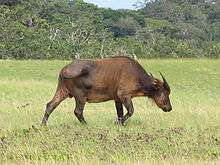Loango National Park
| Loango National Park | |
|---|---|
|
IUCN category II (national park) | |
 | |
| Location | Gabon |
| Coordinates | 2°10′S 9°34′E / 2.167°S 9.567°ECoordinates: 2°10′S 9°34′E / 2.167°S 9.567°E |
| Area | 1,550 km² |
| Established | 2002 |
| Governing body | National Agency for National Parks |
Loango National Park is a national park in western Gabon. It protects diverse coastal habitat, including part of the 220 km² Iguéla Lagoon, the only significant example of a typical western African lagoon system that is protected within a national park.
Situated between the Nkomi and Ndogo Lagoons, Loango National Park is the true jewel of Africa's western coast. The naturalist Mike Fay called Loango 'Africa's Last Eden' and this is where Michael "Nick" Nichols from National Geographic took his well-known pictures of surfing hippos. Both men call Loango the 'Land of surfing hippos'. The park’s 1,550 km² of savanna, pristine beach, forest and mangroves are a must-see in Gabon. Loango National Park offers breathtaking panoramas and the unique opportunity to observe elephants, buffalos, hippos, gorillas and leopards venturing onto the white sand beaches.
After South Africa, the world’s largest concentration and variety of whales and dolphins can be found right off the Loango coast. The area has over 100 kilometres of uninhabited coastline and humpback and killer whales are easy to observe here. This is arguably the most beautiful spot on Africa's western coast – the place where forests, savannas, wetlands, lagoons and ocean all come together. Loango is renowned worldwide as a site for tarpon of record size, as well as many other large saltwater fish.
The World Conservation Union or International Union for the Conservation of Nature and Natural Resources (IUCN), an international organization dedicated to natural resource conservation, classed Loango National Park as a faunal reserve and protected area for conservation.
The history of Loango National Park
In 1956 the first regional faunal reserves were created in and around Loango National Park to promote sustainable use of the area’s wildlife and wild lands. In November 2002, President Omar Bongo Ondimba put Gabon firmly on the map by creating 13 new national parks in Gabon. All together, the thirteen parks created represent 10% of the landmass of Gabon. One of the more spectacular parks in this system is Loango National Park. Very few villages currently exist within the park, as most are located on the opposite bank of the Ngove Lagoon. As such, the park is nearly devoid of people and home only to a vast and spectacular array of terrestrial, avian and marine wildlife. While some of these animals inhabit specific ecological niches to which they have been adapting over time immemorial, others such as elephants and buffalos range across a number of landscapes. Many of the animals can be encountered by visitors on foot, in a vehicle, or seen from a blind.
Tourism and conservation go hand in hand in Loango National Park
Rombout Swanborn, a pioneering Dutch investor in ‘Conservation Tourism’ developed SCD (Société de Conservation de Developpement). Research, park management and educational activities are performed in partnership with WCS. Also, he created Africa’s Eden, developing the infrastructure and logistics to provide high-end nature tourism experiences in remote parts of Gabon (and from 2006 in São Tomé and Príncipe as well) based on the concept "Tourism pays for Conservation".
The people of Loango National Park
Like most peoples around the globe, the human inhabitants of the Loango area remain dependent on the natural resources that surround them for their daily needs. Today, although some Gabonese citizens have migrated toward the urban centres or taken up employment within modern industries, such as oil and timber production, most individuals living in traditional villages still depend heavily upon their natural surroundings for their day-to-day needs.
Village-dwelling peoples use a slash-and-burn agricultural technique and grow a number of domesticated plant species including manioc, peanuts, and mustard greens. Women are responsible for most of the gardening, save for the preliminary felling and clearing of trees and brush. Men make their living by fishing or hunting. Fishermen use long nets, throw nets, gill nets, long lines, baited hooks, fish traps and spears to catch fish and shrimp. Land crabs are caught by hand. Traditional hunting gear such as bows and arrows, spears, deadfall and spring traps, have been replaced by high-calibre rifles and shotguns. A number of other food products are harvested wild in the forest or savannah or from the beaches, such as turtle eggs.
Loango National Park Images
 Elephant with GPS collar, Loango National Park
Elephant with GPS collar, Loango National Park Elephant with offspring roaming
Elephant with offspring roaming Southern Park Camp Site bar with a view
Southern Park Camp Site bar with a view Single Wild Buffalo within the park roaming
Single Wild Buffalo within the park roaming


External links
- Wildlife Conservation Society
- Virtual Tour of the National Parks
-
 Loango National Park travel guide from Wikivoyage
Loango National Park travel guide from Wikivoyage